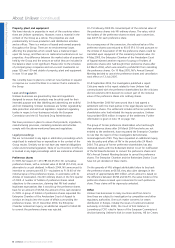Unilever 2006 Annual Report Download - page 21
Download and view the complete annual report
Please find page 21 of the 2006 Unilever annual report below. You can navigate through the pages in the report by either clicking on the pages listed below, or by using the keyword search tool below to find specific information within the annual report.
18 Unilever Annual Report and Accounts 2006
Report of the Directors (continued)
Operating review by region Asia Africa
2006 compared with 2005
Turnover at current rates of exchange rose by 5.7%, after the
impact of acquisitions, disposals and exchange rate changes as
set out in the table above. Operating profit at current rates of
exchange rose by 2.8%, after including an adverse currency
movement of 1.2%. The underlying performance of the business
after eliminating these exchange translation effects and the
impact of acquisitions and disposals is discussed below at
constant exchange rates.
Markets remained buoyant in most of the key countries though
there was a slowdown in consumer spending in Thailand.
Underlying sales growth of 7.7% was broadly based and our
aggregate market shares remained stable.
India grew well across major sectors. A mix of global, regional
and local brands is driving growth, notably Wheel and Surf Excel
in laundry, and Clinic in haircare. A second year of excellent
growth in China, stemmed from a combination of market growth,
better distribution and innovations behind global brands such as
Omo, Lux and Pond’s,as well as the local toothpaste brand,
Zhonghua.Indeed, Unilever Oral Careand Zhonghua exhibited at
the FDI World Dental Federation Congress in China to showcase
‘Live, Learn, Laugh’ – Unilever’sglobal partnership with the
Federation to improve oral health globally.
Indonesia sustained good momentum, not only in the large
Home and Personal Careranges but also in Foods as a result
of strong performances in ice cream and savoury. Thailand had
adisappointing year through weak demand and intense
competition. A major programme of activities is under
way to correct this.
Australia experienced a much improved performance with share
gains in a number of areas. In Japan, Lux Super Rich –the leading
brand – performed well despite the launch of a competitor’s
major brand. However, Dove and Mod’s lost share.
Savoury, ice cream, laundry and household care brands were the
main drivers of strong growth in Turkey, while sales in Arabia
were well ahead.
In South Africa, aggressive price promotions by a local competitor
have reduced laundry sales, but there were strong growth and
sharegains in Foods.
Innovation is increasingly being driven globally and regionally,
rather than locally. The new Sunsilk range has been introduced in
most major markets and in laundry, the Dirt is Good positioning is
now in place across the region. Pond’s Age Miracle,incorporating
unique technology and designed specifically for Asian skin, has
been launched in four countries. Meanwhile the latest global
Axe/Lynx fragrance, Click,has been introduced in Australia and
New Zealand.
As in the rest of the world, the Foods innovation programme
focused on Vitality. Moo, a wholesome children’s ice cream range
based on the goodness of milk, has been very well received by
mothers and children alike and has proven a real success story in
South East Asia. Healthy green tea innovations arebeing rolled
out extensively, while in South Africa marketing for Rama
margarine now communicates the product’s healthy oils.
Addressing the needs of lower income consumers, low-priced
Knorr stock cubes – already successful in Latin America – were
also introduced in the region.
€million €million € million Year on year change Year on year change
at current exchange rates at constant exchange rates
Continuing operations 2006 2005 2006 2005
at current rates of exchange 2006 2005 2004 vs 2005 vs 2004 vs 2005 vs 2004
Turnover 10 863 10 282 9 620 5.7% 6.9% 6.8% 6.9%
Operating profit 1327 1291 1 040 2.8% 24.1% 4.0% 24.7%
Operating margin 12.2% 12.6% 10.8%
Restructuring, business disposals and
impairment charges included in
operating margin (0.3)% 0.0% (2.9)%
2006 2005
Turnover and underlying sales growth vs 2005 vs 2004
Underlying sales growth (%) 7.7 8.7
Effect of acquisitions (%) 0.0 0.0
Effect of disposals (%) (0.8) (1.6)
Effect of exchange rates (%) (1.1) 0.0
Turnover growth (%) 5.7 6.9
Turnover (€ million)
Continuing operations
Asia Africa
Operating margin (%)
Continuing operations
12.2
12.6
10.8
10 863
10 282
9 620
2006
2005
2004
2006
2005
2004
Operating profit (€ million)
Continuing operations
1 327
1 291
1 040
2006
2005
2004
























